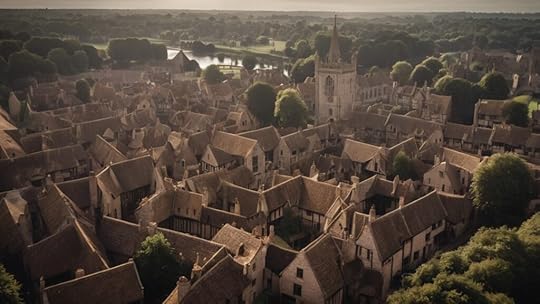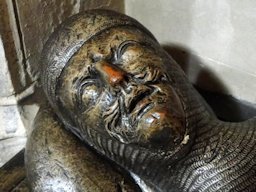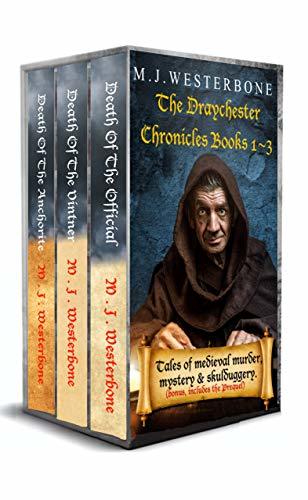M.J. Westerbone's Blog
September 29, 2025
Book Five of the Draychester Chronicles is Almost Here! Death Of The Merchant.
 Book Five of the Draychester Chronicles is Almost Here! Death Of The Merchant.
Book Five of the Draychester Chronicles is Almost Here! Death Of The Merchant.I’m thrilled to announce that my latest medieval crime mystery, “Death of the Merchant,” will be released in just a few days! After months of writing, editing, and polishing, I can finally share this dark medieval tale with you all…
In the shadowy streets of medieval London, where the Thames carries secrets as surely as it carries commerce, a grisly discovery is about to shake the foundations of the city:
In the grim heart of medieval London, some secrets are best left buried in the Thames mud. But when a German merchant is found chained to a river post, his back carved with arcane symbols, those secrets begin to surface…
Once again we follow Bishop Gifford’s trusted officials – Will, Bernard, and Osbert – as they navigate a treacherous landscape where truth is as rare as genuine charity. When the city’s Sheriff hastily declares the merchant’s death an accident, our protagonists know something far more sinister is afoot.
Their investigation will lead them from the imposing Hanseatic Steelyard to the dangerous back-alleys of Southwark, forcing them to question everyone and everything they thought they knew about London.
Available from Amazon shortly, on Kindle, Paperback and Hardback.
The post Book Five of the Draychester Chronicles is Almost Here! Death Of The Merchant. appeared first on M.J.Westerbone.
December 7, 2024
It���s Finally Here: Death of The Wakeman – Book 4 of the Draychester Chronicles!
It���s Finally Here: Death of The Wakeman – Book 4 of the Draychester Chronicles Released!
Its been a long wait (almost 3 years) but book 4 “Death of the Wakeman” in my Draychester Chronicles series has been released and is now available in eBook, Paperback and Hardback from Amazon.
Autumn mists cloak the northern town of Ditton in late 14th century England, where local legend speaks of a beast that haunts the lonely countryside paths after dark…The town���s Wakeman and a local woman are foud dead, their bodies savagely torn in a backstreet slaughter. The frightened townsfolk of Ditton are quick to blame the Shuck���a monstrous black hound of legend with eyes that glow like hellfire.
Bishop Gifford’s trusted officials, Bernard, Will, and Osbert, are dispatched north to investigate the brutal killings. In a town where fact and folklore intertwine and everyone has something to hide, they must untangle truth from superstition. Are these deaths truly the work of a legendary beast made flesh, or is someone using an ancient tale to conceal murder?
The post It���s Finally Here: Death of The Wakeman – Book 4 of the Draychester Chronicles! appeared first on M.J.Westerbone.
It’s Finally Here: Death of The Wakeman – Book 4 of the Draychester Chronicles!
It’s Finally Here: Death of The Wakeman – Book 4 of the Draychester Chronicles Released!
Its been a long wait (almost 3 years) but book 4 “Death of the Wakeman” in my Draychester Chronicles series has been released and is now available in eBook, Paperback and Hardback from Amazon.
Autumn mists cloak the northern town of Ditton in late 14th century England, where local legend speaks of a beast that haunts the lonely countryside paths after dark…The town’s Wakeman and a local woman are foud dead, their bodies savagely torn in a backstreet slaughter. The frightened townsfolk of Ditton are quick to blame the Shuck—a monstrous black hound of legend with eyes that glow like hellfire.
Bishop Gifford’s trusted officials, Bernard, Will, and Osbert, are dispatched north to investigate the brutal killings. In a town where fact and folklore intertwine and everyone has something to hide, they must untangle truth from superstition. Are these deaths truly the work of a legendary beast made flesh, or is someone using an ancient tale to conceal murder?
The post It’s Finally Here: Death of The Wakeman – Book 4 of the Draychester Chronicles! appeared first on M.J.Westerbone.
September 29, 2024
Step Back in Time: Exploring Medieval English Towns
 A Medieval English Town
A Medieval English TownMany of my historical thrillers take place in and around the fictional medieval English city of Draychester. Ever wonder what it was like to live in England hundreds of years ago? Picture yourself strolling down narrow, cobblestone streets, the air filled with the shouts of merchants and the tolling of church bells. Welcome to the world of medieval English towns – bustling hubs of commerce, culture, and daily life that shaped the nation we know today.
Let’s take a whirlwind tour through some of England’s most fascinating medieval towns. Trust me, whether you’re a history buff or just looking for some travel inspiration, you’re in for a treat!
London: Where It All Began
No surprise here – London was the big kahuna even back in the Middle Ages. Imagine the Thames teeming with ships from across Europe, streets packed with traders hawking everything from spices to fine cloth. Despite its size, medieval London had a surprisingly cozy feel, with tight-knit guilds and local parishes creating a sense of community.
York: A Northern Powerhouse
Head north and you’ll hit York, a city that’s been turning heads since Roman times. In the medieval period, York was the place to be, thanks to its prime location and religious clout. The massive York Minster cathedral dominated the skyline (and still does!), while merchants kept the city’s economic engine humming. Walk the old city walls today and you’ll feel like you’ve stepped right into a history book.
Winchester: Before London Was Cool
Before London stole the spotlight, Winchester was England’s seat of power. The Winchester Cathedral is a jaw-dropper, one of Europe’s largest. But it wasn’t all prayer and politics – the town was famous for its rowdy fairs and thriving cloth trade. Stroll through Winchester today and you’ll swear you can hear the echoes of medieval life.
Norwich: Wool You Look at That!
Norwich, in medieval times, it was England’s second-largest city, all thanks to the magical properties of… wool. Seriously, wool was big business, and Norwich was at the heart of it all. The Norwich Cathedral is a Gothic masterpiece, but it was the hardworking merchants and guilds that really put this city on the map.
Canterbury: The OG Pilgrimage Destination
Thanks to Chaucer’s “Canterbury Tales,” we all know Canterbury was the medieval hotspot for pilgrims. They flocked to the shrine of Thomas Becket, turning the town into a medieval tourist trap (in the best way possible). But Canterbury wasn’t just about prayer – it was a buzzing market town where you could find anything your medieval heart desired.
Oxford: Where Brains Met Brawn
Oxford University kicked off in the 12th century, transforming this sleepy town into a hotbed of learning and debate. But don’t think it was all quiet libraries and dusty books. Medieval Oxford students were known for their wild antics, often clashing with the locals in epic “town vs. gown” showdowns.
Bristol: Setting Sail for Adventure
Perched on the River Avon, Bristol was the place to be if you had an itch for adventure. Ships set sail for Ireland and beyond, loaded with wool, wine, and who knows what else. The town was crawling with merchants, sailors, and craftsmen, all looking to make their fortune. Much of medieval Bristol is still standing, so you can channel your inner sea dog as you explore.
Coventry: Weaving a Rich Tapestry
Coventry was medieval England’s textile central, churning out some of the finest cloth around. But it wasn’t all peaceful weaving – Coventry played a big role in the Wars of the Roses, England’s very own “Game of Thrones.” Check out St. Mary’s Guildhall to get a taste of Coventry’s medieval glory days.
Exeter: Guarding the Southwest
Tucked away in the southwest, Exeter was a military and religious powerhouse. Its cathedral is an architectural stunner, and the town was crucial for keeping those pesky western uprisings in check. Take a walk along Exeter’s medieval walls and let your imagination run wild.
Chester: Where Roman Meets Medieval
Chester is like a historical layer cake – Roman foundations topped with medieval charm. Its location near Wales made it a key military outpost, and those impressive walls are still standing today. Chester was also a thriving market town, and you can still see the medieval influence in its famous “Rows” – covered walkways lined with shops.
Why These Towns Still Matter
These medieval English towns aren’t just relics of the past – they’re living, breathing links to our history. Each one has its own unique story, filled with drama, innovation, and the everyday lives of people not so different from us.
Visiting these towns is like stepping into a time machine. You can walk the same streets as medieval merchants, pilgrims, and scholars. It’s a chance to connect with England’s rich past in a way no textbook can match.
So, which town catches your fancy? Whether you’re drawn to London’s bustling energy, York’s ancient walls, or Oxford’s scholarly atmosphere, there’s a medieval adventure waiting for you. Go on, take a step back in time – you might be surprised at how much you have in common with those medieval folk!
The post Step Back in Time: Exploring Medieval English Towns appeared first on M.J.Westerbone.
August 13, 2024
Naughty Medieval Nuns. Wicked women or historical medieval trailblazers?
Naughty Medieval Nuns. Dive into the intriguing world of Medieval history as we uncover the fascinating stories and secrets of naughty medieval nuns. Were these women truly wicked, or were they trailblazers challenging the norms of their time?
The post Naughty Medieval Nuns. Wicked women or historical medieval trailblazers? appeared first on M.J.Westerbone.
Gongfarmers. The dirtiest job in history? Dealing with medieval sh*t!
Gongfarmers. Step back in time and discover the unsung heroes of Medieval history: the gongfarmers. These brave individuals had one of the dirtiest jobs in history, dealing with medieval waste and ensuring the sanitation of bustling medieval towns.
The post Gongfarmers. The dirtiest job in history? Dealing with medieval sh*t! appeared first on M.J.Westerbone.
Medieval Alehouses, Taverns and Inns – Deranged Historian
Step back in time to explore the fascinating world of Medieval alehouses, taverns, and inns—the vibrant social hubs of the Middle Ages. Were these establishments merely places for merriment and community gatherings, or did they also serve as dens of iniquity where illicit activities thrived?
The post Medieval Alehouses, Taverns and Inns – Deranged Historian appeared first on M.J.Westerbone.
March 16, 2021
March Update…
The New Omnibus Edition – Draychester Chronicles 1-3 & the prequel all in one place for the first time.
March, and spring time is not far away here in northern England. It’s been a long winter in many ways and like most of us I am looking forward to better days ahead. Still, there’s some time yet to sit by the fire and read about times past, or, in my case, write about them.
Over the last few weeks I have made great progress on the fourth book in my new Draychester Chronicles series. Will, Bernard and Osbert, in the “Death of the Wakeman”, are once again heading north from Draychester to investigate more medieval, murder, mystery and skulduggery in late 14th century England. I am looking at a release date probably towards the end of spring if things go to plan.
Although book four is a fair few weeks away I do have news of a new omnibus edition which contains not only books one through three but also the prequel book as well! So if you want to jump right in, all 800+ kindle pages of medieval murder are available right now…(it’s also available as a paperback… when you’ve read it you can reuse it as a door stop, it’s that thick…)
The post March Update… appeared first on M.J.Westerbone.
Touch wood��or Knock on wood? God bless you?

The effigy of a crusader knight, carved in wood around 1280,��can be found in Southwark Cathedral, London. He has a shiny��nose for a reason…
Another hangover from our distant past, at least in Britain,�����knocking on wood��� or ���touch wood��� (the usual phrase and action for speakers of English) is the action of literally touching, tapping, or knocking on wood, or at least��stating that you are��doing or intending to do so.
It’s invoked in order to avoid “tempting fate” after making some favourable prediction or boast, or a declaration concerning your own death or another unfavourable situation.
So the story goes,��medieval knights being sent into battle would visit the wooden effigy of a knight in Southwark Cathedral and touch its nose for luck. The Knight’s Tale in The Canterbury Tales begins in Southwark for this reason. The effigy can still be seen in the cathedral to this day.
The origins of the superstition is much older. It derives from the pagan belief that malevolent spirits inhabited wood, and that if you expressed a hope for the future you should touch, or knock on, wood to prevent the spirits from hearing and presumably preventing your hopes from coming true.
Somebody sneezes and you say “bless you”. A familiar event but the practice is believed to have originated in the middle ages. The thought was that the act of sneezing gave Satan the opportunity to enter the body. The person who sneezed needed God’s help to expel the devil, hence “God bless you”. There was also a belief that you could “sneeze out” your soul which was countered by the “God bless you” or covering the face to hold the soul in.
The post Touch wood��or Knock on wood? God bless you? appeared first on M.J.Westerbone.
Touch wood or Knock on wood? God bless you?

The effigy of a crusader knight, carved in wood around 1280, can be found in Southwark Cathedral, London. He has a shiny nose for a reason…
Another hangover from our distant past, at least in Britain, “knocking on wood” or “touch wood” (the usual phrase and action for speakers of English) is the action of literally touching, tapping, or knocking on wood, or at least stating that you are doing or intending to do so.
It’s invoked in order to avoid “tempting fate” after making some favourable prediction or boast, or a declaration concerning your own death or another unfavourable situation.
So the story goes, medieval knights being sent into battle would visit the wooden effigy of a knight in Southwark Cathedral and touch its nose for luck. The Knight’s Tale in The Canterbury Tales begins in Southwark for this reason. The effigy can still be seen in the cathedral to this day.
The origins of the superstition is much older. It derives from the pagan belief that malevolent spirits inhabited wood, and that if you expressed a hope for the future you should touch, or knock on, wood to prevent the spirits from hearing and presumably preventing your hopes from coming true.
Somebody sneezes and you say “bless you”. A familiar event but the practice is believed to have originated in the middle ages. The thought was that the act of sneezing gave Satan the opportunity to enter the body. The person who sneezed needed God’s help to expel the devil, hence “God bless you”. There was also a belief that you could “sneeze out” your soul which was countered by the “God bless you” or covering the face to hold the soul in.
The post Touch wood or Knock on wood? God bless you? appeared first on M.J.Westerbone.





